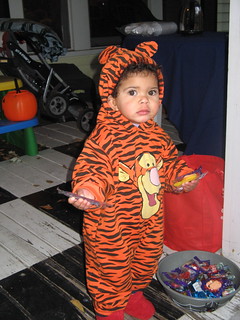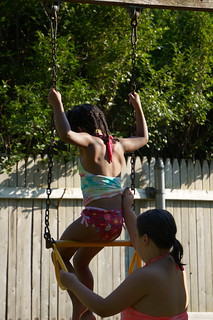Eulogy
Published 11 years, 4 months pastBelow is the eulogy I delivered at Rebecca’s funeral, as I wrote it. I hope that what I actually said matches the text. The same deep shock that let me speak also prevented me from retaining any clear memory of what I said, and I’m not ready to watch the archived recording of the service to find out. I don’t know if I’ll ever be ready. I hope I will — to see Carolyn’s tribute to her sister, if nothing else.
Rebecca was fierce. She beat adults in staring contests when she was two weeks old. Rebecca was joyful. Her laugh could fill a room and bring a smile to anyone who heard it. Rebecca was stubborn. She would often refuse to give in, even when it cost her something she wanted. Rebecca was kind, and loving, and mischievous, and oh so very ticklish.
She vibrated with energy. Her philosophy was essentially: never walk when you can skip, never skip when you can run, never run when you can dance, and never dance when you can hide yourself around the next corner and then laughingly yell “BOO!” when everyone else finally catches up with you.
She loved to steal our phones and wallets and keys from our pockets, not to hide them away or do anything mean or malicious, but to wave them in front of us and laugh her way through an affectionate, singsong tease. If there’s a world beyond this one, I hope whoever’s in charge has secured all the valuables. Not to prevent her from swiping them, which would be an impossible goal, but because she would be disappointed and bored if they were too easy to swipe.
Rebecca is not an angel, nor would she wish to be. If anything, Rebecca is now a poltergeist. On her sixth birthday, we had planned to go to Cedar Point that day and the next. Instead, that was the day she died… and on that day, a water main break closed Cedar Point for the entire weekend, because if she couldn’t go, then nobody gets to go. And in brief conversation this morning, I was literally about to say the words “lose electricity” when the power went out in our house.
The little stinker.
One of the hardest things for us in the last few weeks of her life was seeing how the tumor slowly and inexorably took all that sass and spice away from her. The loss of energy and emotion was horrible. We had fought so long and hard to keep her quality of life normal, and we had succeeded. It was only at the very end, just the last few days, that she moved beyond our ability to preserve it.
Underneath it all, she was still Rebecca. She got mad at her sister and brother because they would get to stay us and she wouldn’t, and then she forgave them because she understood it wasn’t their fault and she loved them so much. She gave us disdainful looks when she thought our attempts to tease her were lame. She asked, wordlessly but clearly, to hear her favorite stories. She told us she didn’t love us because she wanted to push us away, to lessen our pain. But when we explained to her that the joy of loving her was worth any pain, and that we could never stop loving her regardless, she relented and admitted the truth that we had never doubted. The last words and gestures that passed between us were of love.
In her last hours, she was surrounded by love, her room filled with people who loved her as she loved them, never leaving her alone for a second. We held and snuggled her all the way to the end, all of us together. And the people in that room were surrounded by the love of those who loved them, and they by those who loved them. All of that love focused on Rebecca. She deserved it. But then, so does every child.
Now she is gone, and we who remain are devastated. It is only together that we will move forward. Community has sustained us the past months, and made it possible for us to do everything we could for Rebecca and Carolyn and Joshua. Community will help us get through this. Our hearts have been broken into uncountable pieces, but we will help pick up those pieces together. I am beyond heartbroken that she is gone, but I will never, not for an instant, ever regret that she came into our home and our lives.
What matters in this life is not what we do but what we do for others, the legacy we leave and the imprint we make. Her time may have been short, but her spark illuminated so much in that time, touched and warmed so many people, and for the rest of our days we will all be changed for the better.


